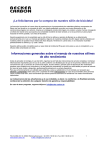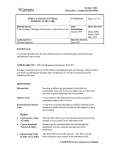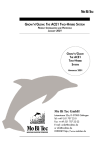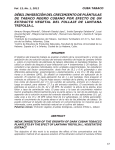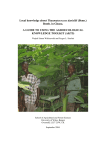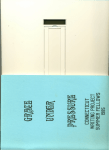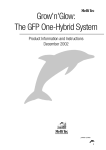Download RESUMEN La Fusariosis de la Espiga de Trigo
Transcript
Resumen RESUMEN La Fusariosis de la Espiga de Trigo (FET) causada por Fusarium graminearum genera pérdidas en rendimiento y contaminación de granos con micotoxinas. Existe escasa variabilidad genética a la resistencia en el germoplasma de trigo candeal. La línea recombinante cromosómica endocriada LDN(Dic-3A), presenta promisorios niveles de resistencia. Los objetivos de esta Tesis comprenden: i)- identificar genes implicados en la resistencia a FET en LDN(Dic-3A); ii)transferir el QTL de resistencia de LDN(Dic-3A) a variedades susceptibles de trigo candeal; iii)desarrollar un ensayo in vitro en plántula para identificar genotipos resistentes y su relación con la severidad de la enfermedad. La identificación de la expresión diferencial de genes inducida en diferentes tiempos postinoculación con F. graminearum entre LDN(Dic-3A) y el parental susceptible LDN se basó principalmente en la técnica de cDNA-AFLP. De ~500 fragmentos derivados de transcripción (TDF) identificados con las distintas combinaciones de cebadores utilizados, 85 mostraron expresión diferencial: el 36% y el 19% fueron identificados en LDN(Dic-3A) y LDN, respectivamente, mientras que el 45% se indujeron en ambos genotipos. Los patrones de TDFs obtenidos mediante cDNA-AFLP demostraron ser reproducibles mediante la técnica de RT-PCR, dando validez a nuestro sistema experimental. La comparación con secuencias depositadas en bases de datos mostró que entre los TDFs identificados se hallan proteínas asociadas a la respuesta temprana a la infección, receptores NBS-LRR y receptores quinasa involucrados en el reconocimiento específico del determinante de avirulencia del patógeno. Fueron identificados además TDFs que, aunque no pudo asignárseles una proteína o función, resultaron específicos de la respuesta a la inoculación. La identidad de TDFs con ESTs de genotecas de espiga de materiales de T. aestivum inoculadas con F. graminearum constituye un sustento adicional para esta afirmación. El mapeo in silico permitió localizar 28 TDFs en el genoma de T. aestivum, siendo el brazo cromosómico 5BL el más representado, además de obtener las regiones genómicas y regulatorias de varios genes. A partir de estas regiones, pudo determinarse la existencia de mecanismos de regulación de la transcripción en común entre algunos genes asociados a los TDFs, entre ellas las proteínas WRKY implicadas en la regulación de los genes asociados con la defensa ante patógenos. La integración de la información obtenida sugiere que la interacción trigo - F. graminearum no sería una interacción compatible como generalmente se XI Resumen cree sino que se trataría de una interacción “gen a gen” que finalmente lleva a la expresión de genes asociados a la defensa. Hemos asumido además el desafío de desarrollar cultivares de trigo candeal resistentes. La compleja herencia de la resistencia y los efectos ambientales, son los responsables del escaso éxito obtenido hasta el momento por los mejoradores en la incorporación al mercado de cultivares resistentes. En este trabajo, por medio de cruzamientos se incorporó el QTL de resistencia Qfhs.ndsu-3AS de LDN(Dic-3A) en los cultivares BESM y BCAN. El microsatélite Xgwm2, ligado al QTL de resistencia permitió reducir la cantidad de individuos que continuaron en el programa de mejoramiento. En la generación F3, se seleccionaron los individuos homocigotos para el alelo de resistencia, y en F4, se evaluó la severidad en espiga identificando individuos con niveles de resistencia similares o mejores que el parental resistente. El programa de mejoramiento continuará con autofecundaciones de genotipos resistentes hasta alcanzar estabilidad en la resistencia junto con la presencia de caracteres agronómicos de interés. La evaluación del comportamiento ante F. graminearum de nuevos materiales requiere de la existencia de ensayos rápidos y confiables. Hemos desarrollado un ensayo in vitro a través de la evaluación de las variables Germinación, Largo de coleoptilo, Peso de coleoptilo, Peso de raíces, utilizando siete variedades comerciales de trigo candeal, el trigo candeal LDN y las líneas resistentes LDN(Dic-3A) y LDN-DGE1 y dos genotipos de trigo pan A601 y A601S3. Las variables de plántula explicaron entre el 51 y el 74% de la severidad de la enfermedad, siendo Largo y Peso de coleoptilo las más eficaces para predecir la resistencia a FET. Los genotipos introgresados mostraron un buen comportamiento en el ensayo en plántula y menor daño en espiga comparados con los susceptibles, sugiriendo que la prueba in vitro es efectiva para la determinación de la resistencia a FET en diferentes fondos genéticos. Entonces, se propone un ensayo in vitro basado en las variables de coleoptilo para evaluar de manera eficaz, rápida y económica el nivel de resistencia a FET, definiendo el Índice de Resistencia en Plántula, altamente correlacionado con severidad, para cada genotipo. Los principales hallazgos de esta Tesis pueden compendiarse indicando que se ha establecido que la interacción trigo - F. graminearum sería una interacción “gen a gen” que lleva a la expresión de genes asociados a la defensa, la obtención de genotipos de trigo candeal resistente a XII Resumen fusariosis de la espiga y el dearrollo de un ensayo in vitro predictor del comportamiento de los genotipos ante la infección. XIII Abstract ABSTRACT Fusarium head blight (FHB) caused by Fusarium graminearum produce yield losses and contamination of grain with mycotoxins. Scarce genetic variability for resistance exists in durum wheat germplasm. The LDN(Dic-3A) recombinant inbred chromosome line showed to be resistant to FBH. The goals of this Thesis include: i)- identification of genes involved in FHB resistance in LDN(Dic-3A); ii)- transference from LDN(Dic-3A) to susceptible durum varieties of the resistance QTL; iii)- development of an in vitro seedling assay to identify wheat resistant genotypes and their relationship with disease severity. Analysis of differential gene expression induced at different time points post- inoculation with F. graminearum between LDN(Dic-3A) and the susceptible parental LDN was performed by cDNA-AFLP technique. A total 85 out of the ~500 transcript-derived fragments (TDFs) identified with the diverse primer combination used showed to be differentially expressed: 36% and 19% were identified in LDN(Dic-3A) and LDN, respectively, whereas 45% were induced in both genotypes. The TDF patterns obtained though cDNA-AFLP showed to be reproducible by RT-PCR, supporting the reliability of our experimental system to identify differentially expressed transcripts. Comparison with protein databases revealed that among the cloned TDFs, several showed identity to proteins associated with early response to infection, to NBS-LRR and kinases receptors involved in specific recognition of avirulence pathogen determinant. However, there was a group of TDFs that, in spite of being specific of the inoculation response, could not be assigned to characterized proteins. The identity of these TDFs with ESTs from libraries from T. aestivum inoculated with Fusarium graminearum additionally supports this affirmation. The availability of T. aestivum genome sequences allowed the in silico mapping of 28 TDFs and the identification of several genes and regulatory regions, being the 5BL chromosome arm where most TDFs were located. The analysis of the regulatory regions revealed the existence of transcription regulation mechanisms shared by some TDFs associated genes, such as WRKY proteins, implied in the regulation of genes associated to pathogen defence. The present results suggest that wheat – F. graminearum interaction is governed by gene-for-gene relationships. The development of resistant cultivars has been a difficult task due to the complex inheritance of resistance and the influence of environmental factors. The resistance QTL Qfhs.ndsu-3AS from XIV Abstract LDN(Dic-3A) was incorporated in the cultivars Buck Emeralda and Buck Candisur through crosses. F3 homozygous individuals for the resistance allele were subjected to marker assisted selection using the Xgwm2 microsatellite, linked to the mentioned QTL, allowing a reduction in the number of individuals included in the following steps of the breeding program. In F4, there were selected the individuals that showed equal or better resistance performances compared to the resistant parent, evaluated through the spike severity at 21 days post-inoculation. The breeding program will continue by selfing resistant genotypes to obtain plant materials that possess both stable resistance and suitable agronomic traits. Rapid and trustable assays are required for the evaluation of germoplasm response to F. graminearum infection. In this Thesis, it was developed an in vitro assay through the evaluation of the variables Germination, Coleoptile length, Coleoptile weight and Root weight using seven varieties of commercial durum, durum wheat cv. LDN and the derived resistant lines LDN(Dic3A) and LDN-DGE1 and two common wheat genotypes, A601 and A601S3. The seedling variables explained between 51 and 74% of the disease severity, being Coleoptile length and weight the ones that more effectively predicted the resistance to FHB. The introgressed genotypes showed better performance in the seedling assay and relatively lower damage in the spikes in relation to susceptible ones, suggesting that this in vitro test can detect FHB resistance in different genetic backgrouds. Thus, we propose an in vitro assay based on coleoptile variables to perform quick, qualified and cost-effective evaluation of the FHB resistance level, defining the Seedling Resistance Index, highly related to severity, for each genotype. Thus, the present Thesis allowed us to postulate that the interaction wheat – F. graminearum could be classified as “gen-for-gen” leading to the expression of defense-related genes. Concurrently, there were obtained genotypes resistant to F. graminearum and it was developed an in vitro assay that predicts the genotypes reponse to infection. XV BIBLIOGRAFÍA Bibliografía Acevedo Vergara R, Araya Mourgues F, Cabello Holley MC, Herrera Barros G, Leyton Buccicardi G, Toro Torres M, Vasquez Toro R y Zerené Zerené M (2008) Estudio de la competitividad de la cadena de trigo candeal. Fundación Chile. Fundación para la Innovación Agraria. Agostinelli AM, Clark AJ, Brown-Guedira G y Van Sanford DA (2012) Optimizing phenotypic and genotypic selection for Fusarium head blight resistance in wheat. Euphytica 186:115126. Alberione E, Arburua M, Fissore G y Fornero G (2013) Eficacia en el control químico de enfermedades foliares en trigo y cebada. Disponible en: http://www.engormix.com/MAagricultura/trigo/articulos/eficacia-control-quimico-enfermedades-t4888/998-p0.htm Altschul SF, Madden TL, Schaffer AA, Zhang J, Zhang Z, Miller W y Lipman DJ (1997) Gapped BLAST and PSI-BLAST: A new generation of protein database search programs. Nucleic Acids Res. 25:3389-3402. Anand A, Zhou T, Trick HN, Gill BS, Bockus WW y Muthukrishnan S (2003) Greenhouse and field testing of transgenic wheat plants stably expressing genes for thaumatin-like protein, chitinase and glucanase against Fusarium graminearum. J. Exp. Bot. 54(384):1101-1111. Andersen L (1948) The development of Gibberella zeae head blight of wheat. Phytopathol. 38:595-611. Atanasoff D (1920) Fusarium-blight (scab) of wheat and other cereals. J. Agricult. Res. 20:1-32. Bachem CWB, Van der Hoeven RS, De Bruijn SM, Vreugdenhil D, Zabeau M y Visser RGF (1996) Visualization of differential gene expression using a novel method of RNA fingerprinting based on AFLP: analysis of gene expression during potato tuber development. Plant J. 9:745-753. Bai GH y Shaner G (1994) Scab of wheat: prospects for control. Plant Dis. 78:760-766. Bai GH, Shaner GE y Ohm HW (2000) Inheritance of resistance to Fusarium graminearum in wheat. Theor. Appl. Genet. 100:1-8. 132 Bibliografía Bai GH, Chen LF y Shaner GE (2003) Breeding for resistance to Fusarium head blight of wheat in China. En: Fusarium Head Blight of Wheat and Barley. Eds. Leonard KJ y Bushnell WR. The American Phytopathological Society, St. Paul, Minnesota 296-317. Bari R y Jones JDG (2009) Role of plant hormones in plant defence responses. Plant Mol. Biol. 69:473-488. Becher R, Miedaner T, Wirsel SGR (2013) Biology, diversity and management of FHB-causing Fusarium species in small-grain cereals. En: The Mycota XI, Agricultural Applications. 2 nd Edition. Ed. Kempken F. Berlin Heidelberg: Springer-Verlag 199-241. Bekele GT (1985) Head scab screening methods used at CIMMYT. En: Wheat for More Tropical Environments. Eds. Villareal RL y Klatt AR. CIMMYT, México 169-173. Berger S (2002) Jasmonate-related mutants of Arabidopsis as tools for studying stress signaling. Planta 214:497-504. Berrocal‐Lobo M, Molina A y Solano R (2002) Constitutive expression of ETHYLENE‐RESPONSE‐FACTOR1 in Arabidopsis confers resistance to several necrotrophic fungi. Plant J. 29(1):23-32. Bhat RV, Beedu SR, Ramakrishna Y y Munshi KL (1989) Outbreak of Trichothecene Mycotoxicosis Associated with Consumption of Mold-Damaged Wheat Products in Kashmir Valley India. Lancet 1:35-37. Boutigny AL, Richard-Forget F y Barreau C (2008) Natural mechanisms for cereal resistance to the accumulation of Fusarium trichothecenes. Eur. J. Plant Pathol. 121(4):411-423. Brennan JM, Fagan B y Van Maanen A (2003) Studies on in vitro growth and pathogenicity of European Fusarium fungi. Eur. J. Plant Pathol. 109:577-587. Breyne P y Zabeau M (2001) Genome-wide expression analysis of plant cell cycle modulated genes. Curr. Opin. Plant Biol. 4:136-142. Browne R y Cooke B (2004) Development and evaluation of an in vitro detached leaf assay for pre-screening resistance to FHB in wheat. Eur. J. Plant Pathol. 110:91-102. 133 Bibliografía Browne R y Cooke B (2005) Resistances of wheat to Fusarium spp. in an in vitro seed germination assay and preliminary investigations into the relationship with Fusarium head blight resistance. Euphytica 141:23-32. Browne RA, Murphy JP, Cooke BM, Devaney D, Walsh EJ, Griffey CA, Hancock JA, Harrison SA, Hart P, Kolb FL, McKendry AL, Milus EA, Sneller C y Van Sanford DA (2005) Evaluation of components of Fusarium head blight resistance in soft red winter wheat germ plasm using a detached leaf assay. Plant Dis. 89(4):404-411. Browne R (2007) Components of resistance to FHB in wheat detected in a seed-germination assay with Microdochium majus and the relationship to FHB disease development and mycotoxin accumulation from Fusarium graminearum infection. Plant Pathol. 56:65-72. Buerstmayr H, Stierschneider M, Steiner B, Lemmens M, Griesser M, Nevo E y Fahima T (2003) Variation for resistance to head blight caused by Fusarium graminearum in wild emmer (Triticum dicoccoides) originating from Israel. Euphytica 130:17-23. Buerstmayr H, Lemmens M, Schmolke M, Zimmermann G, Hartl L, Mascher F, Trottet M, Gosman ME y Nicholson P (2008) Multi-environment evaluation of level and stability of FHB resistance among parental lines and selected offspring derived from several European winter wheat mapping populations. Plant Breed. 127:325-332. Buerstmayr H, Ban T, Anderson JA (2009) QTL mapping and marker-assisted selection for Fusarium head blight resistance en wheat: a review. Plant Breed. 128:1-26. Buerstmayr M, Lemmens M, Steiner B y Buerstmayr H (2011) Advanced backcross QTL mapping of resistance to Fusarium head blight and plant morphological traits in a Triticum macha × T. aestivum population. Theor. Appl. Genet. 123(2):293-306. Buerstmayr M, Hube K, Heckmann J, Steiner B, Nelson J y Buerstmayr H (2012) Mapping of QTL for Fusarium head blight resistance and morphological and developmental traits in three backcross populations derived from Triticum dicoccum x Triticum durum. Theor. Appl. Genet. 125:1751-1765. 134 Bibliografía Buerstmayr M, Alimari A, Steiner B y Buerstmayr H (2013) Genetic mapping of QTL for resistance to Fusarium head blight spread (type 2 resistance) in a Triticum dicoccoides× Triticum durum backcross-derived population. Theor. Appl. Genet. 126(11):2825-2834. Burgess LW, Klein TA, Bryden WL y Tobin NF (1987) Head Blight of Wheat Caused by Fusarium-Graminearum Group 1 in New South Wales Australia in 1983. Australas Plant Pathol. 16:72-78. Bushnell WR, Hazen BE y Pritsch C (2003) Histology and physiology of Fusarium head blight. En: Fusarium head blight of wheat and barley. Eds. Leonard KJ y Bushnell WR. St. Paul, MN: APS Press 44-83. Cai X (2013) USWBSI Durum CP Planning Meeting Report. Disponible en: http://scab.pw.usda.gov/pdfs/DUR-CP_Mtg-Rep_5-13.pdf Cantrell RG y Joppa LR (1991) Genetic analysis of quantitative traits in wild emmer (Triticum turgidum L. var. dicoccoides). Crop Sci. 31:645-649. Carbajo HL, Gualati A, Jensen CA y Loewy T (2001) Cápitulo I: Área de cultivo. Trigo candeal, Manual Técnico. Chara Experimental Integrada INTA-Barrow. Carmona M (2000) Fusariosis: Sintomatología, epidemiología y control. Revista Agromercado 191:58-60. Carmona MA, Formento AN, Luque A y Scandiani MM (2012) Año Niño: Preocupación y alerta por Fusariosis en trigo y cebada: Qué tomar en cuenta? Cómo decidir la aplicación? Que aplicar? Disponible en: http://www.agroconsultasonline.com.ar. Carr JP, Lewsey MG y Palukaitis P (2010) Signaling in induced resistance. Adv. Virus Res. 76:57-121 Cassman KG y Liska AJ (2007) Food and fuel for all: realistic or foolish. Biofuels, Bioprod. Bioref. 1:18-23. 135 Bibliografía Chang WC, Lee TY, Huang HD, Huang HY y Pan RL (2008) PlantPAN: Plant Promoter Analysis Navigator, for identifying combinatorial cis-regulatory elements with distance constraint in plant gene group. BMC Genomics 9:561 Chee PW, Elias EM, Anderson JA y Kianian SF (2001) Evaluation of a high grain protein QTL from Triticum turgidum L. var. dicoccoides in an adapted durum wheat background. Crop Sci. 41:295-301. Chen XM, Line RF y Leung H (1998) Genome scanning for resistance-gene analogs in rice, barley, and wheat by highresolution electrophoresis. Theor. Appl. Genet. 97:345-355. Chen WP, Chen PD, Liu DJ, Kynast R, Friebe B, Velazhahan R, Muthukrishnan S y Gill BS (1999) Development of wheat scab symptoms is delayed in transgenic wheat plants that constitutively express a rice thaumatin-like protein gene. Theor. Appl. Genet. 99(5):755760. Chen X, Faris JD, Hu J, Stack RW, Adhikari T, Elias EM, Kianian SF y Cai X (2007) Saturation and comparative mapping of a major Fusarium head blight resistance QTL in tetraploid wheat. Mol. Breed. 19(2):113-124. Cho SH, Lee J, Jung KH, Lee YW, Park JC y Baek NC (2012) Genome-wide analysis of genes induced by Fusarium graminearum infection in the tolerant and susceptible wheat. J. Plant Biol. 55:64-72. Christensen AB, Thordal-Christensen H, Zimmermann G, Gjetting T, Lyngkjaer MF, Dudler R y Schweizer P (2004) The germinlike protein GLP4 exhibits superoxide dismutase activity and is an important component of quantitative resistance in wheat and barley. Mol. Plant Microbe Interact. 17:109-117. Collard BC y Mackill DJ (2008) Marker-assisted selection: an approach for precision plant breeding in the twenty-first century. Philos. Trans. R. Soc. B Biol. Sci. 363(1491):557572. 136 Bibliografía Collinge DB, Gregersen P y Thordal-Christensen H (1994) The induction of gene expression in response to pathogenic microbes. En: Mechanisms of plant growth and improved productivity, Modern approaches. Ed. Basra, AS. New York, Marcel Dekker 391-433. Conrath U, Pieterse CM y Mauch-Mani B (2002) Priming in plant–pathogen interactions. Trends Plant Sci. 7(5):210-216. Dalcero A, Torres A, Etcheverry M, Chulze S y Varsavsky E (1997) Occurrence of deoxynivalenol and Fusarium graminearum in Argentinean wheat. Food Addit. Contam. 14:11-14. Debener T, Lehnackers H, Arnold M y Dangl JL (1991) Identification and molecular mapping of a single Arabidopsis thaliana locus determining resistance to a phytopathogenic Pseudomonas syringae isolate. Plant J. 1:289-302. Deihimi T, Niazi A, Ebrahimi M, Kajbaf K, Fanaee S, Bakhtiarizadeh MR y Ebrahimie E (2012) Finding the undiscovered roles of genes: an approach using mutual ranking of coexpressed genes and promoter architecture-case study: dual roles of thaumatin like proteins in biotic and abiotic stresses. SpringerPlus 1(1):1-10. Dellaporta SL, Wood J y Hicks J (1983) A plant DNA minipreparation: version II. Plant Mol. Biol. Rep. 1(14):19-21. Del Ponte EM, Fernandes JMC, Pavan W y Baethgen WE (2009) A model-based assessment of the impacts of climate variability on Fusarium head blight seasonal risk in southern Brazil. J. Phytopathol. 157:675-681. De Pater S, Greco V, Pham K, Memelink J y Kijne J (1996) Characterization of a zinc-dependent transcriptional activator from Arabidopsis. Nucleic Acids Res. 24:4624-4631. Desjardins AE y Hohn TM (1997) Mycotoxins in plant pathogenesis. Mol. Plant Microbe Interact. 10:147-152. De Wit PJGM (1997) Pathogen avirulence and plant resistance: a key role for recognition. Trends Plant Sci. 2:452-458. 137 Bibliografía De Wolf ED, Madden LV y Lipps PE (2003) Risk assessment models for wheat Fusarium head blight epidemics based on within-season weather data. Phytopathol. 93:28-435. Diamond H y Cooke B (1999) Towards the development of a novel in vitro strategy for early screening of Fusarium ear blight resistance in adult winter wheat plants. Eur. J. Plant Pathol. 105:363-372. Dill-Macky R y Jones RK (2000) The effect of previous crop residues and tillage on Fusarium head blight of wheat. Plant Dis. 84:71-76. Dill-Macky R (2003) Inoculation methods and evaluation of Fusarium head blight. En: Fusarium Head Blight of Wheat and Barley. Eds. Leonard KJ y Bushnell WR. The American Phytopathological Society, St. Paul, Minnesota 184-210. Ding L, Xu H, Yi H, Yang L, Kong Z, Zhang L, Xue S, Jia H, Ma Z (2011) Resistance to hemibiotrophic F. graminearum infection is associated with coordinated and ordered expression of diverse defense signaling pathways. PLoS One, 6(4): e19008, doi:10.1371/journal.pone.0019008 Di Rienzo JA, Casanoves F, Balzarini MG, Gonzalez L, Tablada M y Robledo CW (2010) InfoStat, versión 2010, Grupo InfoStat. FCA, Universidad Nacional de Córdoba, Argentina. Distelfeld A y Dubcovsky J (2010) Characterization of the maintained vegetative phase (mvp) deletions from einkorn wheat and their effect on VRN2 and FT transcript levels. Mol. Genet. Genomics 283:223-232. Dodds PN y Rathjen JP (2010) Plant immunity: towards an integrated view of plantpathogen interactions. Nature 11:539-548. Draeger R, Gosman N, Steed A, Chandler E, Thomsett M, Srinivasachary, Schondelmaier J, Buerstmayr H, Lemmens M, Schmolke M, Mesterhazy A y Nicholson P (2007) Identification of QTLs for resistance to Fusarium head blight, DON accumulation and associated traits in the winter wheat variety Arina. Theor. Appl. Genet. 115:617-625. 138 Bibliografía Druka A, Kudrna D, Kannangara CG, Von Wettstein D y Kleinhofs A (2002) Physical and genetic mapping of barley (Hordeum vulgare) germin-like cDNAs. Proc. Natl. Acad. Sci. USA 99:850-855. Durrant W, Rowland O, Piedras P y Jones JDG (2000) cDNA-AFLP expression profiling reveals a striking overlap in early gene induction by plant race-specific resistance and by mechanical stress. Plant Cell 12:963-977. Durrant WE y Dong X (2004) Systemic acquired resistance. Annu. Rev. Phytopathol. 42:185209. Eckey C, Korell M, Leib K, Biedenkopf D, Jansen C, Langen G y Kogel KH (2004) Identification of powdery mildew-induced barley genes by cDNA-AFLP: Functional assessment of an early expressed MAP kinase. Plant Mol. Biol. 55:1-15. Elias EM y Manthey FA (2007) Registration of 'Divide' durum wheat. J. Plant Regist. 1:7-8. Ellis J, Dodds P y Pryor T (2000) Structure, function and evolution of plant disease resistance genes. Curr. Opin. Plant Biol. 3:278-284. Eulgem T, Rushton PJ, Schmelzer E, Hahlbrock K y Somssich IE (2003) Early nuclear events in plant defence signalling: rapid gene activation by WRKY transcription factors. EMBO J. 18:4689-4699. FAO (Food and agriculture organization of the United Nations) (2006) http://faostat.fao.org/site/ Feldman M (2001) Origin of cultivated wheat. En: The World Wheat Book. Eds. Bonjean AP y Angus WJ. Lavoisier Publishing, France 3-56. Flor HH (1971) Current status of the gene-for-gene concept. Annu. Rev. Phytopathol. 9:275-296. Formento N y Ramos V (1992) La “fusariosis” de la espiga en cultivares de trigo en la campaña 1991-1992. INTA-EEA Paraná. Carpeta de Información Técnica 1(13):1-4. Formento N, De Souza J y Pérez JM (2003) Estimación de la “Fusariosis de la espiga” (Fusarium graminearum y Fusarium spp.) del trigo en la provincia de Entre Ríos. Año 2002. En: Actualización Técnica Trigo. INTA-EEA Paraná. Serie Extensión 24:30-34. 139 Bibliografía Gabriel DW (1999) Why do pathogens carry avirulence genes? Physiol. Mol. Plant Pathol. 55:205-214. Gabriëls SHEJ, Takken FLW, Vossen JH, de Jong CF, Liu Q, Turk SCHJ, Wachowski LK, Peters J, Witsenboer HMA, de Wit PJGM y Joosten MHAJ (2006) cDNA-AFLP combined with functional analysis reveals novel genes involved in the hypersensitive response. Mol. Plant-Microbe Interact.19:567-576. Galich MT (1987) Importancia y difusión de la fusariosis del trigo en Argentina. En: Taller sobre la fusariosis de la espiga en América del Sur. Ed. Kohli MM. Encarnación, Paraguay. ISBN: 9686127372, 9789686127379. Galich MT, Galich AN, Masiero B, Galarza C y Gudelj V (1996) Aspectos del manejo del cultivo de trigo que influyen en la infección de Fusarium graminearum. Informe Técnico 123. EEA INTA M. Juárez. Galich MT (1997) Fusarium Head Blight in Argentina. En: Fusarium Head Scab: Global Status and Future Prospects. Eds. Dubin HJ, Gilchrist L, Reeves J y McNab A. CIMMYT, México 19-28. Galich M, Alberione E, Helguera M y Bainotti C (2006) Characterization and development of Argentinean wheat germplasm with resistance against Fusarium head blight. En: The Global Fusarium Initiative for International Collaboration. Eds. Ban T, Lewis JM y Phipps EE. CIMMYT, Mexico 121. Gervais L, Dedryver F, Morlais JY, Bodusseau V, Negre S, Bilous M, Groos C y Trottet M (2003) Mapping of quantitative trait loci for field resistance to Fusarium head blight in an European winter wheat. Theor. Appl. Genet. 106:961-970. Ghavami F, Elias EM, Mamidi S, Ansari O, Sargolzaei M, Adhikari T, Mergoum M, Kianian SF (2011) Mixed model association mapping for Fusarium head blight resistance in Tunisian-derived durum wheat populations. G3 (Bethesda, Md) 1:209–218 Gilbert J y Tekauz A (2000) Review: recent developments in research on Fusarium head blight of wheat in Canada. Can. J. Plant Pathol. 22:1-8. 140 Bibliografía Gilbert J y Fernando WGD (2004) Epidemiology and biological control of Gibberella zeae / Fusarium graminearum. Can. J. Plant Pathol. 26:464-472. Gilbert J, Clear RM, Ward TJ, Gaba D, Tekauz A, Turkington TK, Woods SM, Nowicki T y O'Donnell K (2010) Relative aggressiveness and production of 3-or 15-acetyl deoxynivalenol and deoxynivalenol by Fusarium graminearum in spring wheat. Can. J. Plant Pathol. 32(2):146-152. Gilbert J y Tekauz A (2011) Strategies for management of Fusarium Head Blight (FHB) in cereals. Prairie Soils and Crops:Scientific Perspectives for Innovative Management 4:97104. Gilbert J y Haber S (2013) Overview of some recent research developments in Fusarium head blight of wheat. Can. J. Plant Pathol. 35:149-174. Giménez MJ, Pistón F y Atienza SG (2010) Identification of suitable reference genes for normalization of qPCR data in comparative transcriptomics analyses in the Triticeae. Planta 233:163-173. Gladysz C, Lemmens M, Steiner B, Buerstmayr H (2007) Evaluation and genetic mapping of resistance to Fusarium head blight in Triticum dicoccoides. Isr J Plant Sci 55:263–266 Glazebrook J (2005) Contrasting mechanisms of defense against biotrophic and necrotrophic pathogens. Annu. Rev. Phytopathol. 43:205-227. Glowacki S, Macioszek VK, Kononowicz AK (2011) R proteins as fundamentals of plant innate immunity. Cell. Mol. Biol. Lett.16:1-24. Golkari S, Gilbert J, Prashar S y Procunier JD (2007) Microarray analysis of Fusarium graminearum‐induced wheat genes: identification of organ‐specific and differentially expressed genes. Plant Biotechnol. J. 5(1):38-49. Golkari S, Gilbert J, Ban T y Procunier JD (2009) QTL-specific microarray gene expression analysis of wheat resistance to Fusarium head blight in Sumai-3 and two susceptible NILs. Genome 52:409-418. 141 Bibliografía González HHL, Martínez EJ, Pacin A y Resnik SL (1999) Relationship between Fusarium graminearum and Alternaria alternata contamination and deoxynivalenol occurrence on Argentinean durum wheat. Mycopathol. 144:97-102. Goswami RS y Kistler HC (2004) Heading for disaster: Fusarium graminearum on cereal crops. Mol. Plant Pathol. 5(6):515-525. Grant MR, Godiard L, Straube E, Ashfield T, Lewald J, Sattler A, Innes RW y Dangl JL (1995) Structure of the Arabidopsis RPM1 gene enabling dual specificity disease resistance. Science 269:843-846. Gururani MA, Venkatesh J, Upadhyaya CP, Nookaraju A, Pandey SK y Park SW (2012) Plant disease resistance genes: Current status and future directions. Physiol. Mol. Plant P. 78: 51-65. Gus-Mayer S, Naton B, Hahlbrock K y Schmelzer E (1998) Local mechanical stimulation induces components of the pathogen defense response in parsley. Proc. Natl. Acad. Sci. USA 95:8398-8403. Hall TA (1999) BioEdit: a user-friendly biological sequence alignment editor and analysis program for Windows 95/98/NT. Nucl. Acids. Symp. Ser. 41:95-98. Hammond-Kosack KE y Jones JDG (1996) Resistance genedependent plant defense responses. Plant Cell. 8(10):1773-1791. Hammond-Kosack KE y Parker JE (2003) Deciphering plant-pathogen communication: Fresh perspectives for molecular resistance breeding. Curr. Opin. Biotechnol. 14:177-193. Han FP, Fedak G, Ouellet T, Dan H y Somers DJ (2005) Mapping of genes expressed in Fusarium graminearum-infected heads of wheat cultivar 'Frontana'. Genome 48:88-96. Handa H, Namiki N, Xu D y Ban T (2008) Dissecting of the FHB resistance QTL on the short arm of wheat chromosome 2D using a comparative genomic approach: from QTL to candidate gene. Mol. Breed. 27:71-84. 142 Bibliografía Hartel KD, Berzonsky WA, Kianian SF y Ali S (2004) Expression of a Triticum turgidum var. dicoccoides source of Fusarium head blight resistance transferred to synthetic hexaploid wheat. Plant Breed. 123(6):516-519. Hongxiang M, Yao J, Zhou M, Zhang X, Ren L, Yu G y Lu W (2008) Molecular breeding for wheat Fusarium head blight resistance in China. Cereal Res. Commun. 36:203-212. Horsley RD, Pederson JD, Schwarz PB, McKay K, Hochhalter MR y McMullen MP (2006) Integrated use of tebuconazole and Fusarium head blightresistant barley genotypes. Agron. J. 98:194-197. Huang S, Sirikhachornkit A, Su X, Faris J, Gill B, Haselkorn R y Gornicki P (2002) Genes encoding plastid acetyl-CoA carboxylase and 3-phosphoglycerate kinase of the Triticum/Aegilops complex and the evolutionary history of polyploid wheat. Proc. Natl. Acad. Sci. USA 99:8133-8138. Huhn M, Elias E, Ghavami F, Kianian S, Chao S, Zhong S, Alamri M, Yahyaoui A y Mergoum M (2012) Tetraploid Tunisian wheat germplasm as a new source of Fusarium head blight resistance. Crop Sci. 52:136-145. Ishiguro S y Nakamura K (1994) Characterization of a cDNA encoding a novel DNA-binding protein, SPF1, that recognizes SP8 sequences in the 5´ upstream regions of genes coding for sporamin and β-amylase from sweet potato. Mol. Gen. Genet. 244: 563-571. Jauhar PP y Peterson TS (2008) Registration of DGE-1, a durum alien disomic addition line with resistance to Fusarium head blight. J. Plant Regist. 2:167-168. Jauhar PP, Peterson TS y Xu SS (2009) Cytogenetic and molecular characterization of a durum alien disomic addition line with enhanced tolerance to Fusarium head blight. Genome 52(5):467-483. Jauhar PP y Peterson TS (2011) Cytological and Molecular Characterization of Homoeologous Group-1 Chromosomes in Hybrid Derivatives of a Durum Disomic Alien Addition Line. The Plant Genome 4(2):102-109. 143 Bibliografía Jauhar PP y Peterson TS (2012) Registration of DGE-2, a durum wheat disomic alien substitution line 1E(1A) involving a diploid wheatgrass chromosome. J. Plant Regist. 6:221-226. Jauhar PP y Peterson TS (2013) Registration of DGE-3, a durum wheat disomic substitution line 1E(1B) involving a wheatgrass chromosome. J. Plant Regist. 7:257-259. Jara Podestá A (2011) Breve reseña sobre el cultivo de trigo candeal en Argentina. Caracterización y mercados del trigo candeal. Pregón agropecuario en: http://www.pregonagropecuario.com.ar/cat.php?txt=2135. Jones RK (2000) Assessments of Fusarium head blight of wheat and barley in response to fungicide treatment. Plant Dis. 84:1021-1030. Joppa LR y Williams ND (1988) Langdon durum substitution lines and aneuploid analysis in tetraploid wheat. Genome 30:222-228. Joppa LR, Du C, Hart GE y Hareland GA (1997) Mapping gene(s) for grain protein in tetraploid wheat (Triticum turgid L.) using a population of recombinant inbred chromosome lines. Crop Sci. 37:1586-1589. Kang Z y Buchenauer H (2000) Ultrastructural and Immunocytochemical investigation of pathogen development and host responses in resistance and susceptible wheat spikes infected by Fusarium culmorum. Physiol. Mol. Plant Pathol. 57:255-268. Kang JY, Choi HI, Im MY y Kim SY (2002) Arabidopsis basic leucine zipper proteins that mediate stress-responsive abscisic acid signaling. Plant Cell, 14(2):343-357. Kent NL (1983) Technology of cereals: An introduction for students of food science and agriculture. Pergamon Press Ltd, Oxford 13. Khan NI, Schisler DA, Boehm MJ, Slininger PJ y Bothast RJ (2001) Selection and evaluation of microorganisms for biocontrol of Fusarium head blight of wheat incited by Gibberella zeae. Plant Dis. 85:1253-1258. 144 Bibliografía Khan MR, Fischer S, Egan D y Doohan FM (2006) Biological control of Fusarium seedling blight disease of wheat and barley. Phytopathol. 96:386-394. Kilian B, Özkan H, Deusch O, Effgen S, Brandolini A, Kohl J, Martin W y Salamini F (2007a) Independent wheat B and G genome origins in outcrossing Aegilops progenitor haplotypes. Mol. Biol. Evol. 24:217-227. Kilian B, Özkan H, Walther A, Kohl J, Dagan T, Salamini F y Martin W (2007b) Molecular diversity at 18 loci in 321 wild and 92 domesticate lines reveal no reduction of nucleotide diversity during Triticum monococcum (Einkorn) domestication: implications for the origin of agriculture. Mol. Biol. Evol. 24:2657-2668. Kim SR, Choi JL, Costa MA y An G (1992) Identification of G-box sequence as an essential element for methyl jasmonate response of potato proteinase inhibitor II promoter. Plant Physiol. 99:627-631. Kim DJ, Smith SM y Leaver CJ (1997) cDNA encoding a putative SPF1-type DNA-binding protein from cucumber. Gene 185:265–269. Klahr A, Zimmermann G, Wenzel G y Mohler V (2007) Effects of environment, disease progress, plant height and heading date on the detection of QTLs for resistance to Fusarium head blight in an European winter wheat cross. Euphytica 154:17-28. Kliebenstein D (2004) Secondary metabolites and plant/environment interactions: a view through Arabidopsis thaliana tinged glasses. Plant Cell Environ. 27:675-684. Kohli M, Annone J y Galich MTV (1995) Fusariosis de la espiga de trigo y su manejo. En: Las enfermedades del trigo en el Cono Sur. Curso de Manejo de Enfermedades del Trigo. Eds. Kohli M, Annone J, García R. Pergamino, Argentina 164-189. Kombrink E y Somssich IE (1995) Defense responses of plants to pathogens. Adv. Bot. Res. 21:1-34. Kong L, Ohm HW y Anderson JM (2007) Expression analysis of defense-related genes in wheat in response to infection by Fusarium graminearum. Genome 50(11):1038-1048. 145 Bibliografía Kriel WM y Pretorius ZA (2008) The FHB challenge to irrigation wheat production in South Africa. Cereal Res. Commun. 36:569-571. Kugler KG, Siegwart G, Nussbaumer T, Ametz C, Spannagl M, Steiner B, Lemmens M, Mayer KFX, Buerstmayr H y Schweiger W (2013) Quantitative trait loci-dependent analysis of a gene co-expression network associated with Fusarium head blight resistance in bread wheat (Triticum aestivum L.). BMC Genomics 14(1):728. Kumar S, Stack RW, Friesen TL y Faris JD (2007) Identification of a novel Fusarium head blight resistance quantitative trait locus on chromosome 7A in tetraploid wheat. Phytopathol. 97(5):592-597. Lee H, Leon J y Raskin I (1995) Biosynthesis and metabolism of salicylic acid. Proc. Natl. Acad. Sci. USA 92:4076-4079. Leslie JF y Summerell BA (2006) The Fusarium laboratory manual. Oxford, UK: Blackwell Publishing. Li WL, Faris JD, Muthukrishnan S, Liu DJ, Chen PD y Gill BS (2001) Isolation and characterization of novel cDNA clones of acidic chitinases and β-1,3-glucanases from wheat spikes infected by Fusarium graminearum. Theor. Appl. Genet. 102:353-362. Li G y Yen Y (2008) Jasmonate and ethylene signaling pathway may mediate Fusarium head blight resistance in wheat. Crop Sci. 48:1888-1896. Li X, Zhang JB, Song B, Li HP, Xu HQ, Qu B, Dang FJ y Liao YC (2010) Resistance to Fusarium Head Blight and Seedling Blight in Wheat Is Associated with Activation of a Cytochrome P450 Gene. Phytopathol. 100:183-191. Liu S y Anderson JA (2003) Marker assisted evaluation of Fusarium head blight resistant wheat germplasm. Crop Sci. 43:760-766. Livak KJ & Schmittgen TD (2001) Analysis of relative gene expression data using real time quantitative PCR and the 2-ΔΔCt method. Methods 25:402–408 146 Bibliografía Lori G, Sisterna M, Haidukowsky M, Rizzo I (2003) Fusarium graminearum and deoxynivalenol contamination in the durum wheat area of Argentina. Microbiol. Res. 158:1-7. Lu ZX, Gaudet D, Puchalski B, Despins T, Frick M y Laroche A (2006) Inducers of resistance reduce common bunt infection in wheat seedlings while differentially regulating defensegene expression. Physiol. Mol. Plant Pathol. 67:138-148. Maccaferri M, Corneti S, Ricci A, Stefanelli S, Braida E, Lancioni P, Ammar K, Prodi A, Pisi A, Pascale M, Lippolis V, Massi A y Tuberosa R (2013) Genetic dissection of Fusarium head blight response in a durum wheat elite population. En: Abstracts. International Symposium Genetics and Breeding of Durum Wheat. ENEA, Rome 161. Mackintosh CA, Lewis J, Radmer LE, Shin S, Heinen SJ, Smith LA, Wyckoff MN, Dill-Macky R, Evans CK, Kravchenko S, Baldridge GD, Zeyen RJ y Muehlbauer GJ (2007) Overexpression of defense response genes in transgenic wheat enhances resistance to Fusarium head blight. Plant Cell Rep. 26(4):479-488. Madriz K (2002) Mecanismos de defensa en las interacciones planta-patógeno. Manejo Integrado de Plagas 3:22-32. Malihipour A, Gilbert J, Piercey-Normore M y Cloutier S (2012) Molecular phylogenetic analysis, trichothecene chemotype patterns, and variation in aggressiveness of Fusarium isolates causing head blight in wheat. Plant Dis. 96:1016-1025. Marchionatto JB (1934) Enfermedades del trigo poco conocidas y radicadas en la región oeste de la zona triguera. Boletín del Ministerio de Agricultura de la Nación 36:293-299. Mardi M, Pazouki L, Delavar H, Kazemi MB, Ghareyazie B, Steiner B, Nolz R, Lemmens M y Buerstmayr H (2006) QTL analysis of resistance to Fusarium head blight in wheat using a 'Frontana'-derived population. Plant Breed. 125:313-317. Matus-Cádiz MA, Pozniak CJ, Hughes GR y Hucl P (2006) Multiplexed PCR to screen for a major QTL carrying Fusarium head blight resistance in Sumai-3 wheat. Can J Plant Sci. 86(3):711-716. 147 Bibliografía Mauch-Mani B y Metraux J (1998) Salicylic acid and systemic acquired resistance to pathogen attack. Ann. Bot. 82:535-540. McCormick S (2003) The role of DON in pathogenicity. En: Fusarium Head Blight of Wheat and Barley. Eds. Leonard KJ y Bushnell WR. The American Phytopathological Society, St. Paul, Minnesota 165-183. McFadden ES y Sears ER (1944) The artificial synthesis of Triticum spelta. Rec. Genet. Soc. Am. 13:26-27. McMullen MP, Stack RW y Casper H (1994) Vomitoxin levels in durum and hard red spring wheats infected with Fusarium head blight in 1993. Biol. Cultiv. Tests for Control of Plant Dis. 9:116. McMullen M, Jones R, Gallenberg D (1997) Scab of wheat and barley: a reemerging disease of devasting impact. Plant Dis. 81:1340-1348. McMullen M (2003) Impacts of Fusarium head blight on the North American agriculture community: the power of one disease to catapult change. Pages 484-503 in: Fusarium Head Blight of Wheat and Barley. Eds. Leonard KJ y Bushnell WR. The American Phytopathological Society, St. Paul, Minnesota. McMullen M (2007) Integrated strategies for FHB management, a Northern Great Plains Perspective. En: 5th Canadian Workshop on Fusarium Head Blight. Winnipeg, Manitoba. Canadian Grain Commission, Winnipeg, Manitoba 83-87. McMullen M, Halley S, Schatz B, Meyer S, Jordahl J, Ransom J (2008) Integrated strategies for Fusarium head blight management in the United States. Cereal Res. Commun. 36:563568. McMullen M, Bergstrom G, De Wolf E, Dill-Macky R, Hershman D, Shaner G, Van Sanford D (2012) A unified effort to fight an enemy of wheat and barley: Fusarium head blight. Plant Dis. 96:1712-1728. Mesterházy Á (1978) Comparative analysis of artificial inoculation methods with Fusarium spp. on winter wheat varieties. J. Phytopathol. 93:12-25. 148 Bibliografía Mesterházy Á (1987) Selection of head blight resistant wheat through seedling resistance. Plant Breed. 98:25-36. Mesterházy Á (1995) Types and components of resistance to Fusarium head blight of wheat. Plant Breed. 114:377-386. Mesterházy Á, Bartók T, Mirocha CM y Komoróczy R (1999) Nature of resistance of wheat to Fusarium head blight and deoxynivalenol contamination and their consequences for breeding. Plant Breed. 118:97-110. Mesterházy Á (2003) Conrol of Fusarium head blight of wheat by fungicides. En: Fusarium Head Blight of Wheat and Barley. Eds. Leonard KJ y Bushnell WR. The American Phytopathological Society, St. Paul, Minnesota 363-380. Miedaner T (1997) Review: Breeding wheat and rye for resistance to Fusarium disease. Plant Breed. 116:201-220. Miller JD, Young JC y Sampson DR (1985) Deoxynivalenol and Fusarium Head Blight resistance in spring cereals. J. Phytopathol. 113:359-367. Miller JD, Culley J, Fraser K, Hubbard S, Meloche F, Ouellet T, Seaman WL, Seifert KA, Turkington K y Voldeng H (1998) Effect of tillage practice of Fusarium head blight of wheat. Can. J. Plant Pathol. 20:95-103. Moschini RC y Fortugno C (1996) Predicting wheat head blight incidence using models based on meteorological factors in Pergamino, Argentina. Eur. J. Plant Pathol. 102:211-218. Mueller MJ (1997) Enzymes involved in jasmonic acid biosynthesis. Physiol. Plant 100:653663. Mysore KS y Ryu CM (2004) Nonhost resistance: how much do we know?. Trends Plant Sci. 9:97-104. Nganje WE, Bangsund DA, Leistritz FL, Wilson WW y Tiapo NM (2004) Regional economic impacts of Fusarium head blight in wheat and barley. Appl. Econ. Perspect. Pol. 26:332347. 149 Bibliografía O’Donnell K, Kistler HC, Tacke BK y Casper HH (2000) Gene genealogies reveal global phylogeographic structure and reproductive isolation among lineages of Fusarium graminearum, the fungus causing wheat scab. Proc. Natl. Acad. Sci. USA 97:7905-7910. O’Donnell K, Ward TJ, Geiser DM, Kistler HC y Aoki T (2004) Genealogical concordance between the mating type locus and seven other nuclear genes supports formal recognition of nine phylogenetically distinct species within the Fusarium graminearum clade. Fungal Genet. Biol. 41:600-623. O’Donnell K, Ward TJ, Aberra D, Kistler HC, Aoki T, Orwig N, Kimura M, Bjørnstad S y Klemsdal SS (2008) Multilocus genotyping and molecular phylogenetics resolve a novel head blight pathogen within the Fusarium graminearum species complex from Ethiopia. Fung. Genet. Biol. 45:1514-1522. Oliver R, Stack R, Miller J y Cai X (2007) Reaction of wild emmer wheat accessions to Fusarium head blight. Crop Sci. 47:893-899. Oliver RE, Cai X, Friesen TL, Halley S, Stack RW, Xu SS (2008) Evaluation of Fusarium head blight resistance in tetraploid wheat (Triticum turgidum L.). Crop Sci. 48:213-222. Ori N, Eshed Y, Paran I, Presting G, Aviv D, Tanksley S, Zamir D y Fluhr R (1997) The I2C family from the wilt disease resistance locus I2 belongs to the nucleotide binding, leucine-rich repeat superfamily of plant resistance genes. Plant Cell. 9(4):521-532. Otto CD, Kianian SF, Elias EM, Stack RW y Joppa LR (2002) Genetic dissection of a major Fusarium head blight QTL in tetraploid wheat. Plant Mol. Biol. 48:625-632. Paillard S, Schnurbusch T, Tiwari R, Messmer M, Winzeler M, Keller B y Schachermayr G (2004) QTL analysis of resistance to Fusarium head blight in Swiss winter wheat (Triticum aestivum L.) Theor. Appl. Genet. 109:323-332. Palazzini JM, Ramirez ML, Torres AM y Chulze SN (2007) Potential biocontrol agents for Fusarium head blight and deoxynivalenol production in wheat. Crop Prot. 26:1702-1710. Parry DW, Jenkinson P y McLeod L (1995) Fusarium ear blight (scab) in small-grain cereals – a review. Plant Pathol. 44:207-238. 150 Bibliografía Patnaik D y khurana P (2001) Wheat biotechnology: A minireview. Electron. J. Biotechnol. ISSN: 0717-3458. Paul PA, Lipps PE, Hershman DE, McMullen MP, Draper MA y Madden LV (2007) A quantitative review of tebuconazole effect on Fusarium head blight and deoxynivalenol content in wheat. Phytopathol. 97:211-220. Pearce RB, Strange RN y Smith H (1976) Glycinebetaine and choline in wheat: Distribution and relation to infection by Fusarium graminearum. Phytochem. 15(6):953-954. Peng JH, Sun D y Nevo E (2011) Domestication evolution, genetics and genomics in wheat. Mol. Breed. 28(3):281-301. Peng JH, Sun DF, Peng YL y Nevo E (2012) Gene discovery in Triticum dicoccoides, the direct progenitor of cultivated wheats. Cereal Research Communications DOI: 10.1556/CRC.2012.0030. Pestka JJ (2010) Deoxynivalenol: mechanisms of action, human exposure, and toxicological relevance. Arch. Toxicol. 84:663-679. Pinheiro JC y Bates DM (2000) Mixed-Effects Models in S and S-PLUS. Springer, New York. Polesani M, Desario F, Ferrarini A, Zamboni A, Pezzotti M, Kortekamp A y Polverari A (2008) cDNA-AFLP analysis of plant and pathogen genes expressed in grapevine infected with Plasmopara viticola. BMC Genomics 9:142. Pozniack CJ, Clarke JM, Singh AK, Thomas J y Fedak G (2007) Progress in Fusarium head blight resistance breeding in Canadian Durum Wheat. In Proceedings of 5th Canadian Workshop on Fusarium Head Blight. Winnipeg, Manitoba, Canadá 47. Prandini A, Sigolo S, Filippi L, Battilani P y Piva G (2008) Review of predictive models for Fusarium head blight and related mycotoxin contamination in wheat. Food Chem. Toxicol. 47: 927-931. 151 Bibliografía Pritsch C, Muehlbauer GJ, Bushnell WR, Somers DA y Vance CP (2000) Fungal development and induction of defense response genes during early infection of wheat spikes by Fusarium graminearum. Mol. Plant-Microbe Interact. 13(2):159-169. Pritsch C, Vance CP, Bushnell WR, Somers DA, Hohn TM y Muehlbauer GJ (2001) Systemic expression of defense response genes in wheat spikes as a response to Fusarium graminearum infection. Physiol. Mol. Plant 58(1):1-12. Purahong W, Alkadri D, Nipoti P, Pisi A, Lemmens M y Prodi A (2012) Validation of a modified Petri-dish test to quantify aggressiveness of Fusarium graminearum in durum wheat. Eur. J. Plant Pathol. 132:381-391. Purahong W, Nipoti P, Pisi A, Lemmens M y Prodi A (2014) Aggressiveness of different Fusarium graminearum chemotypes within a population from Northern-Central Italy. Mycoscience 55:63-69. R Development Core Team (2008) R: A language and environment for statistical computing. R Foundation for Statistical Computing, Vienna, Austria. http://www.R-project.org. Ramírez ML, Reynoso MM, Farnochi MC y Chulze S (2006) Vegetative compatibility and mycotoxin chemotypes among Fusarium graminearum (Gibberella zeae) isolates from wheat in Argentina. Eur. J. Plant Pathol. 115:139-148. Ramírez V, García-Andrade J y Vera P (2011) Enhanced disease resistance to Botrytis cinerea in myb46 Arabidopsis plants is associated to an early down-regulation of CesA genes. Plant Signal. Behav. 6(6):911-913. Ravensdale M, Rocheleau H, Wang L, Nasmith C, Ouellet T y Subramaniam R (2014) Components of priming‐induced resistance to fusarium head blight in wheat revealed by two distinct mutants of Fusarium graminearum. Mol. Plant Pathol. DOI: 10.1111/mpp.12145 Reis EM y Carmona M (2002) Fusariosis del trigo. Biología, epidemiología y estrategias para su manejo. Eds. Reis y Carmona. Buenops Aires, Argentina. ISBN: 98743-3959-4. 152 Bibliografía Ribichich KF, Lopez SE y Vegetti AC (2000) Histopathological spikelet changes produced by Fusarium graminearum in susceptible and resistant wheat cultivars. Plant Dis. 84:794802. Röder MS, Korzun V, Wandehake K, Planschke J, Tixier MH, Leroy P y Ganal MW (1998) A microsatellite map of wheat. Genetics 149:2007-2023. Ruan Y, Comeau A, Langevin F, Hucl P, Clarke JM, Brule-Babel A y Pozniak CJ (2012) Identification of novel QTL for resistance to Fusarium head blight in a tetraploid wheat population. Genome 55(12):853-864. Rudd JC, Horsley RD, Mckendry AL y Elias EM (2001) Host plant resistance genes for Fusarium head blight: sources, mechanisms and utility in conventional breeding systems. Crop Sci. 41:620-627. Rushton PJ y Somssich IE (1998) Transcriptional control of plant genes responsive to pathogens. Curr. Opin. Plant Biol. 1(4):311-315. Ryals JA, Neuenschwander UH, Willits MG, Molina A, Steiner HY y Hunt MD (1996) Systemic acquired resistance. Plant Cell 8:1809-1819. Simons G, Groenendijk J, Wijbrandi J, Reijans M, Groenen J, Diergaarde P, Van der Lee T, Bleeker M, Onstenk J, de Both M, Haring M, Mes J, Cornelissen B, Zabeau M y Vos P (1998) Dissection of the fusarium I2 gene cluster in tomato reveals six homologs and one active gene copy. Plant Cell 10(6):1055-1068. Salamini F, Özkan H, Brandolini A, Schäfer-Pregl R y Martin W (2002) Genetics and geography of wild cereal domestication in the Near East. Nat. Rev. Genet. 3:429-441. Sambrook J, Maniatis T, Fritsch ET (1989) Molecular Cloning, a Laboratory Manual. 2ed. Book1. Cold Spring Harbor Laboratory Press, New York, EE.UU. Sarver B, Ward T, Gale L, Broz K, Kistler HC, Aoki T, Nicholson P, Carter J y O’Donnell K (2011) Novel Fusarium head blight pathogens from Nepal and Louisiana revealed by multilocus genealogical concordance. Fungal Genet. Biol. 48:1096-1107. 153 Bibliografía Schaller F, Biesgen C, Müssig C, Altmann T y Weiler EW (2000) 12-Oxophytodienoate reductase 3 (OPR3) is the isoenzyme involved in jasmonate biosynthesis. Planta 210(6):979-984. Schisler DA, Khan NI, Boehm MJ, Lipps PE, Slininger PJ y Zhang S (2006) Selection and evaluation of the potential of choline-metabolizing microbial strains to reduce Fusarium head blight. Biol. Control 39:497-506. Schmolke M, Zimmermann G, Buerstmayr H, Schweizer G, Miedaner T, Korzun V, Ebmeyer E y Hartl L (2005) Molecular mapping of Fusarium head blight resistance in the winter wheat population Dream/Lynx. Theor. Appl. Genet. 111:747-756. Schmolke M, Zimmermann G, Schweizer G, Miedaner T, Korzun V, Ebmeyer E y Hartl L (2008) Molecular mapping of quantitative trait loci for field resistance to Fusarium head blight in a European winter wheat population. Plant Breed. 127:459-464. Schrödter R (2004) Influence of harvest and storage conditions on trichothecenes levels in various cereals. Toxicol. Lett. 153:47-49. Schroeder HW y Christensen JJ (1963) Factors affecting resistance of wheat to scab caused by Gibberella zeae. Phytopathol. 53:831-838. Schulze-Lefert P (2004) Knocking on the heaven’s wall: pathogenesis of and resistance to biotrophic fungi at the cell wall. Curr. Opin. Plant Biol. 7:377-383. Schweiger W, Steiner B, Ametz C, Siegwart G, Wiesenberger G, Berthiller F, Lemmens M, Jia H, Adam G, Muehlbauer GJ, Kreil DP y Buerstmayr H (2013) Transcriptomic characterization of two major Fusarium resistance quantitative trait loci (QTLs), Fhb1 and Qfhs.ifa-5A, identifies novel candidate genes. Mol. Plant Pathol. DOI: 10.1111/mpp.12048. Sestili S, Polverari A, Luongo L, Ferrarini A, Scotton M, Hussain J, Delledonne M, Ficcadenti N y Belisario A (2011) Distinct colonization patterns and cDNA-AFLP transcriptome profiles in compatible and incompatible interactions between melon and different races of Fusarium oxysporum f. sp. melonis. BMC Genomics 12:122. 154 Bibliografía Shang J, Tao Y, Chen X, Zou Y, Lei C, Wang J, Li X, Zhao X, Zhang M, Lu Z, Xu J, Cheng Z, Wan J y Zhu L (2009) Identification of a new rice blast resistance gene, Pid3, by genome wide comparison of paired nucleotide-binding site leucine-rich repeat genes and their pseudogene alleles between the two sequenced rice genomes. Genetics 182:1303-1311. Shi C, Yan P, Li J, Wu H, Li Q y Guan S (2014) Biocontrol of Fusarium graminearum growth and deoxynivalenol production in wheat kernels with bacterial antagonists. Int. J. Environ. Res. Publ. Health 11:1094-1105. Scott DB, De Jager EJH y Van Wyk PS (1988) Head blight of irrigated wheat in South Africa. Phytophylactica 20:317-319. Snijders CHA y Van Eeuwijk FA (1991) Genotype by strain interactions for resistance to Fusarium head blight caused by Fusarium culmorum in winter wheat. Theor. Appl. Genet. 81:239-244. Solá I (2013) Toxinas en trigos y harinas. Toxicología y Nutrición del INTI Agroalimentos. Disponible en: http://www.laarena.com.ar/includes/modulos/print.php?id=98015&seccionid Somers DJ, Fedak G y Savard M (2003) Molecular mapping of novel genes controlling Fusarium head blight resistance and deoxynivalenol accumulation in spring wheat. Genome 46:555564. Somers DJ, Fedak G, Clarke J y Cao WG (2006) Mapping of FHB resistance QTLs in tetraploid wheat. Genome 49(12):1586-1593. Somssich IE y Hahlbrock K (1998) Pathogen defence in plants - a paradigm of biological complexity. Trends Plant Sci. 3:86-90. Song WY, Wang GL, Chen LL, Kim HS, Pi LY, Holsten T, Gardner J, Wang B, Zhai WX, Zhu LH, Fauquet C y Ronald P (1995) A receptor kinase-like protein encoded by the rice disease resistance gene, Xa21. Science 270:1804-1806. 155 Bibliografía Srinivasachary, Gosman N, Steed A, Simmonds J, Leverington-Waite M, Wang Y, Snape J, Nicholson P (2008) Susceptibility to Fusarium head blight is associated with the Rht-D1b semi-dwarfing allele in wheat. Theor. Appl. Genet. 116:1145-1153. Stack RW (1988) Response of durum wheat to head blight. Biol. Cultiv. Tests for Control of Plant Dis. 3:39. Stack RW, Elias EM y Joppa LR (1999) Fusarium head blight reaction of durum wheat lines conditioned by Triticum dicoccoides chromosome substitutions. Phytopathol. 89:S74 (abstract). Stack RW (2000) Return of an old pathogen: Fusarium head blight of small grains. Plant Management Network International. Disponible en: http://www.plantmanagementnetwork.org/php/default.asp. Stack RW, Elias EM, Mitchell Fetch J, Miller JD y Joppa LR (2002) Fusarium head blight reaction of LDN durum-substitution lines. Crop Sci. 42:637-642. Stack RW (2003) History of Fusarium head blight with emphasis on North America. En: Fusarium Head Blight of Wheat and Barley. Eds. Leonard KJ y Bushnell WR. The American Phytopathological Society Press, St. Paul, Minnesota 1-34. Stack RW, Faris J (2006) Identification of a Fusarium head blight resistance QTL on chromosome 6B in tetraploid wheat (abstract). Plant and Animal Genome XIV Conference. Abstract no P285:172 Starkey DE, Ward TJ, Aoki T, Gale LR, Kistler HC, Geiser DM, Suga H, Tóth B, Varga J y O'Donnell K (2007) Global molecular surveillance reveals novel Fusarium head blight species and trichothecene toxin diversity. Fungal Genet. Biol. 44:1191-1204. Steiger DK, Elias EM y Cantrell RG (1996) Evaluation of lines derived from wild emmer chromosome substitutions. I. Quality traits. Crop Sci. 36:223-227. Steiner B, Lemmens M, Griesser M, Scholz U, Schondelmaier J y Burstmayr H (2004) Molecular mapping of resistance to Fusarium head blight in the spring wheat ultivar Frontana. Theor. Appl. Genet. 109:215-224. 156 Bibliografía Steiner B, Kurz H, Lemmens M y Buerstmayr H (2009) Differential gene expression of related wheat lines with contrasting levels of head blight resistance after Fusarium graminearum inoculation. Theor. Appl. Genet.118(4):753-764. Stitcher L, Mauch-Mani B y Metraux JP (1997) Systemic acquired resistance. Annual Rev. Phytopathol. 35:235-270. Strange RN, Majer JR y Smith H (1974) The isolation and identification of choline and betaine as two major components in anthers and wheat germ that stimulate Fusarium graminearum in vitro. Physiol. Plant Pathol. 4:277-290. Takegami S (1957) Studies on the resistance of wheat varieties to Giberella zea (Schw.) Petch (head blight) and is mechanism. 1. Varietal differences of the position of florets in the wheat spikelet. Sci. Rep. Fac. Agric. 10:33-42. Tamburic-Ilincic L, Schaafsma AW, Fedak G y Falk DE (2000) Selecting for FHB resistance in early generations of winter wheat populations. In Proceedings of the 2000 National Fusarium Head Blight Forum. Erlanger, KY United States 284-287. Tanno K y Willcox G (2006) How fast was wild wheat domesticated? Science 311:1886. Tekauz A, McCallum B y Gilbert J (2000) Review: Fusarium head blight of barley in western Canada. Can. J. Plant Pathol. 22:9-16. Tekauz A, McCallum B, Ames N y Fetch JM (2004) Fusarium head blight of oat current status in western Canada. Can. J. Plant Pathol. 26:473-479. Thatcher L, Anderson J y Singh K (2005) Plant defense responses: what have we learnt from Arabidopsis? Func. Plant Biol. 32:1-19. Trail F (2009) For blighted waves of grain: Fusarium graminearum in the postgenomics era. Plant Physiol. 149:103-110. Tsunewaki K (2009) Plasmon analysis in the Triticum-Aegilops complex. Breed. Sci. 59:455470. Turner JG, Ellis C y Devoto A (2002) The jasmonate signal pathway. Plant Cell 14:153-S164. 157 Bibliografía Turner NW, Subrahmanyam S y Piletsky SA (2009) Analytical methods for determination of mycotoxins: a review. Anal. Chim. Acta 632:168-180. Van Eeuwijk FA, Mesterházy A, Kling CI, Ruckenbauer P, Saur L, Buerstmayr H, Lemmens M, Keizer LCP, Maurin N y Snijders CHA (1995) Assessing non-specificity of resistance in wheat to head blight caused by inoculation with European strains of Fusarium culmorum, F. graminearum and F. nivale using a multiplicative model for interaction. Theor. Appl. Genet. 90(2):221-228. Van Loon LC, Rep M y Pieterse CMJ (2006) Significance of inducible defense-related proteins in infected plants. Annu. Rev. Phytopathol. 44:135-162. Van Slageren MW (1994) Wild wheats: a monograph of Aegilops L. and Amblyopyrum (Jaub. and Spach) Eig (Poaceae). Agricultural University, Wageningen & International Center for Agricultural Research in Dry Areas, Aleppo, Syria. Vargas PR y Fernández JMC (1997) Modelando o curso da antese em trigo. Fitopatologia Brasileira 22:317. Velazquez P y Formento AN (2013) Efecto de la fusariosis de la espiga del trigo (Fusarium graminearum y Fusarium spp.) en un cultivar susceptible. Campaña 2012. Paraná, Entre Ríos. Jornada Regional de Cultivos de Invierno. ISBN 978-950-698-308-6 Vidhyasekaran P (2008) Fungal pathogenesis in plants and crops: molecular biology and host defence mechanism. 2a ed. CRC Press. 536. Vogelgsang S, Hecker A, Musa T, Dorn B y Forrer HR (2011) On-farm experiments over 5 years in a grain maize/winter wheat rotation: effect of maize residue treatments on Fusarium graminearum infection and deoxynivalenol contamination in wheat. Mycotoxin Res. 27:81-96. Vlot AC, Klessig DF, Park SW (2008) Systemic acquired resistance: the elusive signal(s). Curr. Opin. Plant Biol. 11:436-442. Vorwerk S, Somerville S y Somerville C (2004) The role of plant cell wall polysaccharide composition in disease resistance. Trends Plant Sci. 9:203-209. 158 Bibliografía Vos P, Hogers R, Bleeker M, Reijans M, van de Lee T, Hornes M, Frijters A, Pot J, Peleman J, Kuiper M y Zabeau M (1995) AFLP: a new technique for DNA fingerprinting. Nucleic Acids Res. 23:4407-4414. Walsh P, Bursac D, Law YC, Cyr D y Lithgow T (2004) The J-protein family: modulating protein assembly, disassembly and translocation. EMBO Rep. 5:567-571. Wan YF, Yen C y Yang JL (1997) Sources of resistance to head scab in Triticum. Euphytica 94:31-36. Wang YZ (1997) Epidemiology and management of wheat scab in China. En: Fusarium head scab: global status and future prospects. Eds. Dubin HJ, Gilchrist L, Reeves J y McNab A. Mexico, DF, CIMMYT. Wang Z, Yang P, Fan B y Chen Z (1998) An oligo selection procedure for identification of sequence-specific DNA-binding activities associated with plant defense. Plant J. 16:515522. Wang X, Tang C, Zhang G, Li Y, Wang C, Liu B, Qu Z, Zhao J, Han Q, Huang L, Chen X y Kang Z (2009) cDNA-AFLP analysis reveals differential gene expression in compatible interaction of wheat challenged with Puccinia striiformis f. sp. tritici. BMC Genomics 10:289. Wang Y y Wu WH (2013a) Potassium transport and signaling in higher plants. Annu. Rev. Plan Biol. 64:451-476. Wang M, Zheng Q, Shen Q y Guo S (2013b) The critical role of potassium in plant stress response. Int. J.Mol. Sci. 14(4):7370-7390. Ward TJ, Bielawski JP, Kistler HC, Sullivan E y O’Donnell K (2002) Ancestral polymorphism and adaptive evolution in the trichothecene mycotoxin gene cluster of phytopathogenic Fusarium. Proc. Natl. Acad. Sci. USA 99:9278-9283. Wegulo SN, Bockus WW, Hernandez Nopsa JF, Peiris KHS y Dowell FE (2013) Integration of fungicide application and cultivar resistance to manage Fusarium head blight in wheat. Disponible en: http://dx.doi.org/10.5772/53096 159 Bibliografía Wiermer M, Feys BJ y Parker JE (2005) Plant immunity: the EDS1 regulatory node. Curr. Opin. Plant Biol. 8:383-389. Willyerd KT, Li C, Madden LV, Bradley CA, Bergstrom GC, Sweets LE, McMullen M, Ransom JK, Grybauskas A, Osborne L, Wegulo SN, Hershman DE, Wise K, Bockus WW, Groth D, Dill-Macky R, Milus E, Esker PD, Waxman KD, Adee EA, Ebelhar SE, Young BG y Paul PA (2012) Efficacy and stability of integrating fungicide and cultivar resistance to manage Fusarium head blight and deoxynivalenol in wheat. Plant Dis. 96:957-967. Woo EJ, Dunwell JM, Goodenough PW, Marvier AC y Pickersgill RW (2000) Germin is a manganese containing homohexamer with oxalate oxidase and superoxide dismutase activities. Nat. Struct. Biol. 7:1036-1040. Wu AB, Li HP, Zhao CS y Liao YC (2005) Comparative pathogenicity of Fusarium graminearum isolates from China revealed by wheat coleoptile and floret inoculations. Mycopathologia 160:75-83. Xiao J, Jin X, Jia X, Wang H, Cao A, Zhao W, Pei H, Xue Z, He L, Chen Q y Wang X (2013) Transcriptome-based discovery of pathways and genes related to resistance against Fusarium head blight in wheat landrace Wangshuibai. BMC Genomics 14(1):197. Xu X (2003) Effects of environmental conditions on the development of Fusarium ear blight. Eur. J. Plant Pathol. 109:683-689. Yamaguchi T, Minami E, Ueki J y Shibuya N (2005) Elicitor-induced activation of phospholipases plays an important role for the induction of defense responses in suspension-cultured rice cells. Plant Cell Physiol. 46:579-587. Yamaguchi-Shinozaki K y Shinozaki K (1994) A novel cis-acting element in an Arabidopsis gene is involved in responsiveness to drought, low-temperature, or high-salt stress. Plant Cell 6:251-64. Yamaguchi-Shinozaki K y Shinozaki K (2005) Organization of cis-acting regulatory elements in osmotic- and cold-stress-responsive promoters. Trends Plant Sci 10:88-94. 160 Bibliografía Yli-Mattila T, Gagkaeva T, Ward TJ, Aoki T, Kistler HC y O’Donnell K (2009) A novel Asian clade within the Fusarium graminearum species complex includes a newly discovered cereal head blight pathogen from the far east of Russia. Mycologia 101:841-852. Yoda H, Hiroi Y y Sano H (2006) Polyamine oxidase is one of the key elements for oxidative burst to induce programmed cell death in tobacco cultured cells. Plant Physiol 142:193206. Zhang Z, Schwartz S, Wagner L y Miller W (2000) A greedy algorithm for aligning DNA sequences. J. Comput. Biol. 7:203-214. Zhang L, Meakin H y Dickinson M (2003) Isolation of genes expressed during compatible interactions between leaf rust (Puccinia triticina) and wheat using cDNA-AFLP. Mol. Plant Pathol. 4:469-477. Zhang X, Zhou MP, Ren LJ, Bai GH, Ma HQ, Scholten OE, Guo PG y Lu WZ (2004) Molecular characterization of Fusarium head blight resistance from wheat variety Wangshuibai. Euphytica 139:59-64. Zhang G y Mergoum M (2007) Molecular mapping of kernel shattering and its association with Fusarium head blight resistance in a Sumai3 derived population. Theor. Appl. Genet. 115:757-766. Zhang C, Wang Y, Wang J, Zhai Z, Zhang L, Zheng W, Yu W, Zhou J, Lu G, Shim WB y Wang Z. (2013) Functional characterization of Rho family small GTPases in Fusarium graminearum. Fungal Genet. Biol. 61:90-99. Zimmermann G, Baümlein H, Mock HP, Himmelbach A y Schweizer P (2006) The multigene family encoding germin-like proteins of barley. Regulation and function in basal host resistance. Plant Physiol. 142:181-192. 161






































